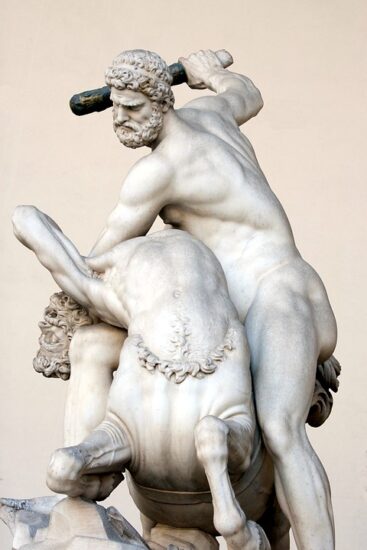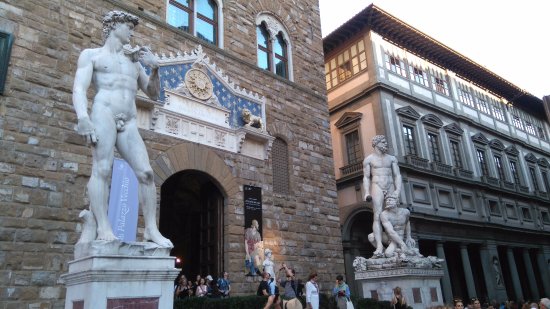Piazza della Signoria
On the south side of Via dei Calzaiuoli, the most important square of historic Florence, the Piazza della Signoria the historical and political heart of Florence. The most prominent feature of the piazza is the Palazzo della Signoria also known as Palazzo Vecchio. Today this monumental building is Florence’s town hall, the seat of the local government, a working building housing many offices that Florentines use on a daily basis, as well as the mayor’s office.
Built on the site of a first-century Roman theater (the ruins of which can now be visited), the first phase of the Palazzo was constructed between 1298 and 1302 by Arnolfo di Cambio, although it was enlarged several times thereafter. Its distinctive tower was added in 1310. The internal courtyard, updated by Michelozzo and decorated by Giorgio Vasari known as the Cortile di Michelozzo, is open to the public free of charge; the Palazzo Museum itself has an admission charge.

If you are facing the Palazzo’s facade, then to your right lies an impressive arcaded loggia built between 1376 and 1382 by Benci di Cione and Simone Talenti. It was originally called the Loggia dei Priori since it provided shelter for outdoor ceremonies marking the change of the priori, or city rulers, that took place here every two months.
To this day the loggia provides free, covered seating for tired tourists amongst its treasures of Renaissance and Ancient art. It is now better known as the Loggia dei Lanzi after the Lanzichenecchi, German mercenaries who stood guard over the palace. In addition to some heavily restored Roman statues, the loggia is home to Benvenuto Cellini‘s 1545 bronze Perseus, a tour de force of bronze casting and Giambologna‘s spiraling Mannerist Rape of the Sabine Women of 1583. The Rape of Polyxena by Pio Fedi and Giambologna‘s Hercules and the Centaur can also be found in the loggia.



Several other notable works of sculpture adorn the Piazza della Signoria. To the left of the door of the Palazzo is a copy of Michelangelo’s David, marking the location where the original stood from 1504 until it was moved to the Accademia in 1873. To the right of the door is Baccio Bandinelli’s Hercules and Cacus from 1534, whose base is ringed by wonderfully expressive animals’ heads.
A copy of Donatello’s diminutive but powerful Judith Slaying Holofernes in bronze is also located in front of the Palazzo (the original is inside). To the far left of the Palazzo is the Neptune Fountain whose main figure bears the features of Cosimo I, sculpted by Bartolomeo Ammannati.
The fountain is featured prominently in the stabbing scene in the film A Room With a View. Toward the center of the piazza is a more flattering bronze equestrian statue of Cosimo I by Giambologna. The Trade Tribunal (Tribunale di Mercanzia) of 1359, from which trade was regulated and merchant disputes settled, is located at the short end of the piazza. Emblems of the guilds appear in a frieze above the second story of its facade. Part of this building now houses the brand new Gucci Museum (opened in the fall of 2011).


If you’d like to just sit back and soak in the history, take a table at two of Florence’s most famous cafes. The prices will be high for table service, but the location coupled with your preferred drink are well worth the expense. A century-old erborista selling lovely perfumes and soaps is located nearby at Via Vacchereccia, 9/r.
There are also more tourist oriented restaurants on the southeast side of the piazza and in the northeast corner, as well as several lodging options, including the prestigious Palazzo Uguccioni. Of course there are also a wide variety of hotels near Piazza Signoria also. (Description by http://www.piazza-signoria.com/)



